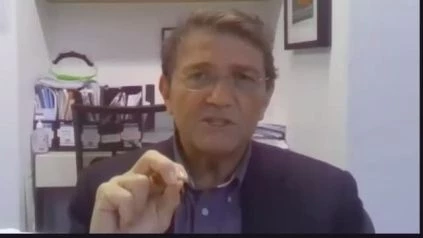Miles Prince, MD of Peter MacCallum Cancer Centre discusses the ASH 2020 abstract – The ECHELON-2 Trial: 5-year Results of a Randomized, Double-Blind, Phase 3 Study of Brentuximab Vedotin and CHP (A+CHP) Versus CHOP in Frontline Treatment of Patients with CD30-Positive Peripheral T-Cell Lymphoma.
Introducing
The phase 3 ECHELON-2 analysis (NCT01777152) showed that frontline therapy with brentuximab vedotin (BV) plus cyclophosphamide, doxorubicin, and prednisone (A+CHP) was superior in patients (pts) with systemic anaplastic large cell lymphoma (sALCL) or other CD30-expressing peripheral T-cell lymphomas (PTCL) to cyclophosphamide, doxorubicin, vincristine, and prednisone (CHOP) (Horowitz S, et al. Lancet 2019). The hazard ratio (HR) (0.71 [95% confidence interval {CI}: 0.54, 0.93], P=0.01) preferred A+CHP over CHOP with a median follow-up of 36.2 months for progression-free survival (PFS). The median PFS was 48.2 months (95 percent CI: 35.2, not evaluable) versus 20.8 months for A+CHP and CHOP, respectively (95 percent CI: 12.7, 47.6). The HR (0.66 [95 percent CI: 0.46, 0.95], P=0.02) also preferred A+CHP over CHOP with a median follow-up of 42.1 months for overall survival (OS). For either arm, the median OS was not achieved. With these observations, the first treatment regimen to demonstrate an OS advantage over CHOP in this pt population was A+CHP. Here, we record findings with a median follow-up for PFS of 44.3 months and for OS of 55.5 months.
Methodology
A randomized, double-blind double-dummy, placebo-controlled, active-comparator, multicenter, phase 3 study is ECHELON-2. For six or eight cycles, qualifying adult pts with previously untreated CD30-positive PTCL (targeting 75%±5 percent with sALCL) were randomized to A+CHP or CHOP. By histological subtype and international prognostic index ranking, randomization has been stratified. In the primary study, the primary PFS endpoint was evaluated per blinded independent central evaluation and per investigator in this revised analysis. OS, PFS in sALCL, full remission (CR) rate, and objective response rate were the main secondary endpoints (ORR). Subsequent therapies were allowed, including BV or BV-containing regimens.
Outcomes
A total of 452 pts were introduced and 1:1 was randomized with 226 pts in each arm. The research included advanced disease pts (Stage III [27 percent] and Stage IV [53 percent]; IPI [78 percent]); most pts (316 [70 percent]) had sALCLL due to goal enrollment (218 [48 percent ] anaplastic lymphoma kinase [ALK]-negative and 98 pts [22 percent ] ALK-positive). The HRs for PFS per investigator (0.70 [95% CI: 0.53, 0.91], P=0.0075) (Figure 1) and OS (0.74 [95% CI: 0.54, 1.02], P=0.0688) appear to favour A+CHP over CHOP with additional follow-up. The median PFS was 63.5 months (95 percent CI: 42.0, not evaluable) versus 23.8 months for A+CHP and CHOP, respectively (95 percent CI: 13.6, 55.9). For the A+CHP arm, the projected 5-year PFS was 50.9% (95 percent CI: 42.1, 59.1) versus 42.7% (95 percent CI: 35.3, 49.8) for the CHOP arm. For either arm, the median OS was not achieved. For the A+CHP arm, the projected 5-year OS was 68.7% (95 percent CI: 61.3, 75.0) versus 60.3% (95 percent CI: 52.8, 67.0) for the CHOP arm. In general, the PFS tests for main preset subgroups were consistent with the overall results of the analysis (Figure 2). The HR for PFS (0.55 [95% CI: 0.39, 0.78]) also favors A+CHP over CHOP in the sub-set of pts with sALCL, with an average 5-year PFS of 59.8 percent (95% CI: 48.0, 69.7) for the A+CHP arm versus 48.1 percent (95% CI: 39.1, 56.6) for the CHOP arm. Subsequent systemic therapy with BV was given to a total of 23 pts (10 percent) in the A+CHP arm (16 pts with sALCL, 4 pts with PTCL not otherwise defined, and 3 pts with angioimmunoblastic T-cell lymphoma) and 51 pts (23 percent) in the CHOP arm. The median retreat period in the A+CHP arm was 12.3 months (range, 3, 51); 15 pts (ORR: 65 percent) had CR (9 pts) or partial remission (6 pts) following BV monotherapy (21 pts) or BV-containing regimen retreatment (2 pts). With additional follow-up in pts with treatment-emergent peripheral neuropathy (PN) (117 pts A+CHP and 124 pts CHOP), these incidents were either resolved or enhanced by 68% of pts in the A+CHP arm compared to 77% of pts in the CHOP arm. Of the pts with continuing PN events at the last follow-up, 73% in the A+CHP arm and 74% in the CHOP arm had grade 1 events, 25% and 23% of pts had grade 2 events, respectively, and 2% of pts in each arm had grade 3 events.
Findings
Frontline therapy with A+CHP continues to provide clinically important progress in PFS and OS versus CHOP at 5 years, including consistent remission with a manageable safety profile in ~60 percent of pts with sALCL, including ongoing resolution or improvement of PN.
Additional 5-year findings will be discussed, including data from prespecified subgroups.

